Bulk Green Tea for Wholesale Buyers
Our bulk green tea is carefully sourced from premium Camellia sinensis gardens to provide consistent quality for wholesalers, distributors, and exporters. At ACPFOOD, we supply Camellia sinensis leaves wholesale for international buyers seeking premium tea for food, beverage, and herbal industries, ensuring reliable supply in bulk quantities.
GENERAL DATA
Plant parts: Leaves
Cultivation mode: Cultivated
In manufacturing: Pharmaceutical, beverages, perfumery, moisturizer, cosmetics, shampoos, creams, toothpaste, haircare, skincare, chewing gums, alcoholic drinks, oil, extract.
In food: Tea.
🍃 Industries That Use Green Tea (Camellia sinensis L.)
These leaves, derived from the unoxidized leaves of Camellia sinensis, is globally recognized for its high antioxidant content, mild bitterness, and wide-ranging applications in wellness, functional foods, and cosmetics. Unlike black tea, green tea is minimally processed, preserving its bioactive compounds.
1. Food & Beverage Industry
These leaves are a staple in the health-conscious beverage market and is used both in traditional brews and modern food formulations.
Applications:
-
Loose-leaf and bagged green teas for everyday consumption
-
Ready-to-drink cold brews and green tea-based energy drinks
-
Flavoring agent in candies, jellies, chocolates, and desserts
-
Culinary ingredient in matcha lattes, smoothies, and sauces
✅ Popular in keto, clean-label, and low-caffeine beverages
✅ Labeled as antioxidant-rich, fat-burning, and metabolism-supportive
2. Nutraceutical & Health Supplement Industry
It is extensively used in dietary supplements, functional foods, and detox products due to its potent catechins, especially EGCG.
Applications:
-
Weight-loss capsules and metabolism boosters
-
Detox teas and liver health formulations
-
Brain health and mood support (thanks to L-theanine + caffeine synergy)
-
Cardiovascular supplements to manage cholesterol and inflammation
✅ Backed by clinical studies for fat oxidation and thermogenesis
✅ Popular in natural nootropic blends and longevity products
3. Cosmetic & Personal Care Industry
Its extracts, rich in antioxidants and anti-inflammatory compounds, are common in natural beauty and skincare formulations.
Applications:
-
Anti-aging and acne-control creams (EGCG reduces oxidative stress)
-
Facial toners and mists for sensitive skin
-
Sunscreens and after-sun gels (UV-protective properties)
-
Hair serums and scalp tonics (reduces dandruff and oiliness)
✅ Known for soothing irritated skin and neutralizing free radicals
✅ Widely used in Korean, Japanese, and Ayurvedic-inspired skincare
✅ Being explored for Alzheimer’s prevention and cognitive enhancement
✅ Common in integrative medicine and functional nutrition
5. Confectionery, Functional Bakery & Culinary Use
Green tea and matcha powder are used in trendy, health-forward bakery and dessert lines.
Applications:
-
Green tea cookies, cakes, mochi, and ice cream
-
Energy bars with Matcha and nuts or Dates
-
Smoothies, protein shakes, and adaptogen blends
-
Culinary seasoning or umami enhancer in sauces
✅ Loved by wellness influencers and culinary innovators
✅ “Matcha” is a premium sub-category of powdered green tea
6. Academic & Scientific Research
Green tea has been widely researched for its bioactive profile, particularly EGCG and its role in:
Research Areas:
-
Anti-obesity and thermogenic mechanisms
-
Neuroprotection and mental performance
-
DNA repair and cancer prevention
-
Gut microbiota modulation
✅ Over 5,000 peer-reviewed studies on green tea polyphenols
✅ Central to functional food, nutraceutical, and phytomedicine research
✅ Summary of Key Applications
| Industry | Common Uses |
|---|---|
| Food & Beverage | Brewed tea, matcha lattes, flavored drinks |
| Nutraceutical & Health | Weight loss, detox, cardiovascular & cognitive health |
| Cosmetic & Personal Care | Skin serums, anti-acne creams, scalp tonics |
| Pharmaceutical & Medical | Cardioprotective, antimicrobial, and neuroprotective uses |
| Confectionery & Culinary | Matcha desserts, functional pastries, seasoning |
| Academic & Research | EGCG, antioxidant, metabolic and neuro studies |
🌟 Key Features
-
Rich in catechins, especially EGCG (Epigallocatechin gallate)
-
Contains caffeine + L-theanine for calm alertness
-
Supports metabolism, brain function, detoxification
-
Widely used in both traditional medicine and modern wellness
-
Available as loose tea, extract, capsules, matcha powder
🍵 Comparison of Black Tea, Green Tea, and White Tea
| Attribute | 🖤 Black Tea | 🍃 Green Tea | 🤍 White Tea |
|---|---|---|---|
| Botanical Source | Camellia sinensis | Camellia sinensis | Camellia sinensis |
| Processing Level | Fully oxidized | Minimally oxidized | Least processed (withered and dried only) |
| Oxidation | High | Very low | None or minimal |
| Caffeine Content | High (~40–70 mg/cup) | Moderate (~20–45 mg/cup) | Low (~15–30 mg/cup) |
| Color (Brewed) | Deep red-brown | Pale green to yellow-green | Pale gold or ivory |
| Flavor Profile | Bold, malty, astringent | Grassy, vegetal, mildly bitter | Delicate, light, slightly floral or sweet |
| Key Compounds | Theaflavins, thearubigins, caffeine | EGCG, catechins, L-theanine | Catechins, gallic acid, polyphenols |
| Antioxidant Capacity | Moderate | High (esp. EGCG) | Very high (least degraded by processing) |
| Notable Benefits | Heart health, alertness | Weight loss, metabolism, brain function | Anti-aging, skin health, cellular protection |
| L-theanine (calming amino acid) | Moderate | High | High |
| Tannins (bitterness/astringency) | High | Moderate | Low |
| Shelf Life | Long (up to 3 years if stored well) | Medium (6–12 months for best quality) | Short (very delicate; 6 months optimal) |
| Form Factors | Loose leaf, tea bags, instant tea | Loose leaf, matcha powder, extract, RTD drinks | Loose buds, sachets, premium whole-leaf teas |
| Common Uses | Breakfast teas, milk teas, iced teas, kombucha | Health drinks, matcha lattes, supplements | Luxury teas, skincare, antioxidant blends |
| Popularity Region | India, UK, Russia, Middle East | China, Japan, Korea, global health markets | China (Fujian), premium wellness sectors |
| Industrial Uses | Functional food, cosmetics, pharma, kombucha | Nutraceuticals, weight-loss, cosmeceuticals | Skincare, anti-aging, luxury wellness products |
🧪 Summary of Functional Differences
| Tea Type | Oxidation | Antioxidant Power | Caffeine | Main Bioactives | Best For |
|---|---|---|---|---|---|
| Black Tea | High | Moderate | High | Theaflavins, caffeine | Energy, heart health, rich flavor lovers |
| Green Tea | Low | High | Medium | EGCG, L-theanine | Weight loss, alert calmness, antioxidants |
| White Tea | Minimal | Very High | Low | Catechins, polyphenols | Skin, anti-aging, gentle detox |
PRODUCT NAME IN DIFFERENT LANGUAGES
Persian Name: چای سبز/ Chai-e-Sabz
German Name (Deutschland, Austria, Switzerland): Teestrauch
French Name (France, Belgium, Switzerland, Quebec): Thé vert
HARVEST CALENDAR
Feb
Mar
Apr
May
Jun
Jul
Aug
Sep
Oct
Nov
Dec
To order Green Tea leaves, please contact us.
About Camellia Sinensis
Green tea and Black tea are both made from tea leaves and differ only in color and type of preparation method. Its bright color is green or olive green and it is so called because of its green color.
Camellia Leaves Temperament
Hot and dry.
Camellia Sinensis Chemical Constituents
The chemical composition of Green tea is complex: proteins (15-20% dry weight), whose enzymes constitute an important fraction; amino acids (1-4% dry weight) such as theanine or 5-N-ethylglutamine, glutamic acid, tryptophan, glycine, serine, aspartic acid, tyrosine, valine, leucine, threonine, arginine, and lysine;
Carbohydrates (5-7% dry weight) such as cellulose, pectins, glucose, fructose, and sucrose; minerals and trace elements (5% dry weight) such as calcium, magnesium, chromium, manganese, iron, copper, zinc, molybdenum, selenium, sodium, phosphorus, cobalt, strontium, nickel, potassium, fluorine, and aluminum; and trace amounts of lipids (linoleic and α-linolenic acids), sterols (stigmasterol), vitamins (B, C, E), xanthic bases (caffeine, theophylline), pigments (chlorophyll, carotenoids), and volatile compounds (aldehydes, alcohols, esters, lactones, hydrocarbons).
Camellia Sinensis Health Benefits
- Brew it with Black tea and White tea equally and drink it. It is a stimulant and stops diarrhea.
- Drink its brewed tea. Kills viruses and bacteria, neutralizes the activity of carcinogens, lowers high blood pressure and cholesterol and protects blood vessels, stops the flu and herpes viruses.
🍵 Nutrition Facts – Green Tea (Dried Leaves)
(Camellia sinensis L.)
Serving Size: 2 g (~1 teaspoon dried loose leaf)
Calories: ~5 kcal (unbrewed)
| Nutrient | Amount per 2g | Per 100g |
|---|---|---|
| Total Fat | 0.02 g | 1.0 g |
| • Saturated Fat | 0.003 g | 0.15 g |
| Cholesterol | 0 mg | 0 mg |
| Sodium | 0.4 mg | 20 mg |
| Total Carbohydrate | 1.0 g | 50.0 g |
| • Dietary Fiber | 0.2 g | 10.0 g |
| • Natural Sugars | 0 g | 0 g |
| Protein | 0.2 g | 10.0 g |
⚠️ Brewed green tea (240 ml cup) contains only 0–3 kcal.
🍃 Functional & Phytochemical Profile (Per 100g dried):
| Compound / Group | Approx. Content | Functional Role |
|---|---|---|
| Catechins (EGCG, ECG, EGC) | 15–30% | Potent antioxidants, metabolic & cardiovascular support |
| Caffeine | 2–4% | Cognitive stimulant, enhances alertness |
| L-theanine | 0.6–1.2% | Calming amino acid, promotes relaxed focus |
| Flavonoids | High | Antioxidant, cell protective |
| Chlorophyll | Present | Detoxifying, antioxidant |
| Tannins | Moderate | Astringent, digestive support |
🧬 Vitamins & Minerals (Per 100g, dried):
| Micronutrient | Approx. Content | % DV (per 100g) |
|---|---|---|
| Manganese | ~1.9 mg | 95% |
| Potassium | ~2,200 mg | 63% |
| Magnesium | ~220 mg | 55% |
| Iron | ~17 mg | 94% |
| Calcium | ~330 mg | 33% |
| Vitamin C | ~60 mg | 67% |
| Vitamin K | ~1,200 µg | 1,000%+ |
☕ Brewed Green Tea (240 ml cup – unsweetened):
| Nutrient / Compound | Approximate Amount |
|---|---|
| Calories | 0–3 kcal |
| Caffeine | 25–45 mg |
| L-theanine | 5–10 mg |
| Catechins | ~100–200 mg |
| Vitamin C | 2–8 mg |
🍵 Green tea is made from unoxidized leaves of Camellia sinensis, preserving a high level of catechins and antioxidants. Traditionally used to support alertness, digestion, immunity, and healthy aging.
✅ Rich in EGCG (epigallocatechin gallate), theanine, and polyphenols. A staple in functional foods and traditional medicine.
⚠️ Contains caffeine. Excessive intake may lead to insomnia or interfere with iron absorption. Consume in moderation.
Percent Daily Values are based on a 2,000-calorie diet. Nutrient content varies by origin, leaf quality, and processing method.
To order loose leaf Green Tea, please contact us.




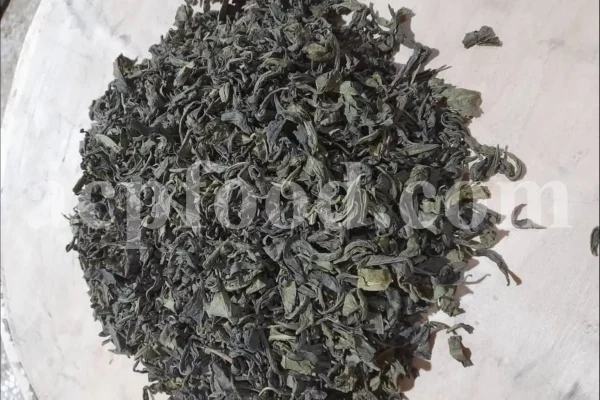
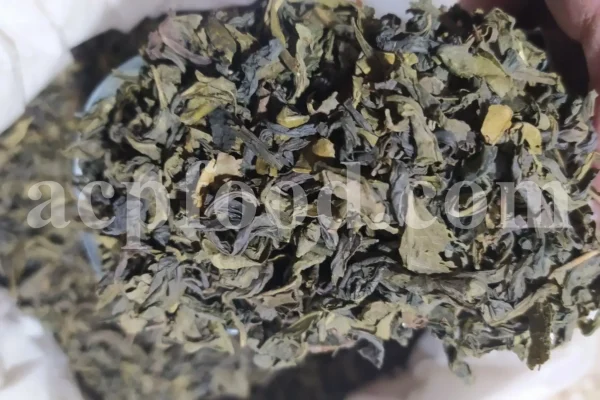

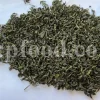
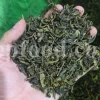
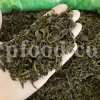


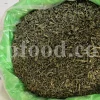

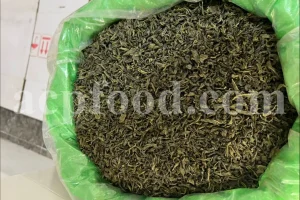
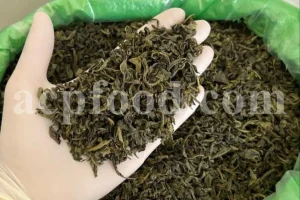
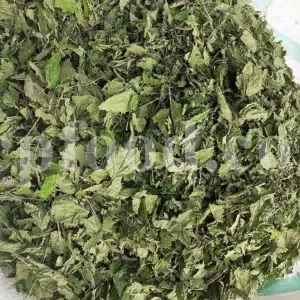
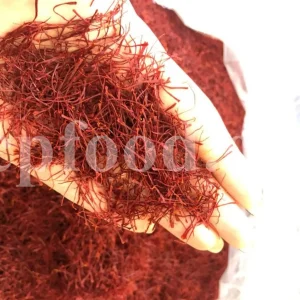

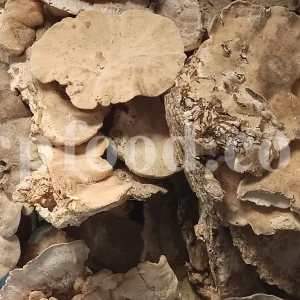
Reviews
There are no reviews yet.